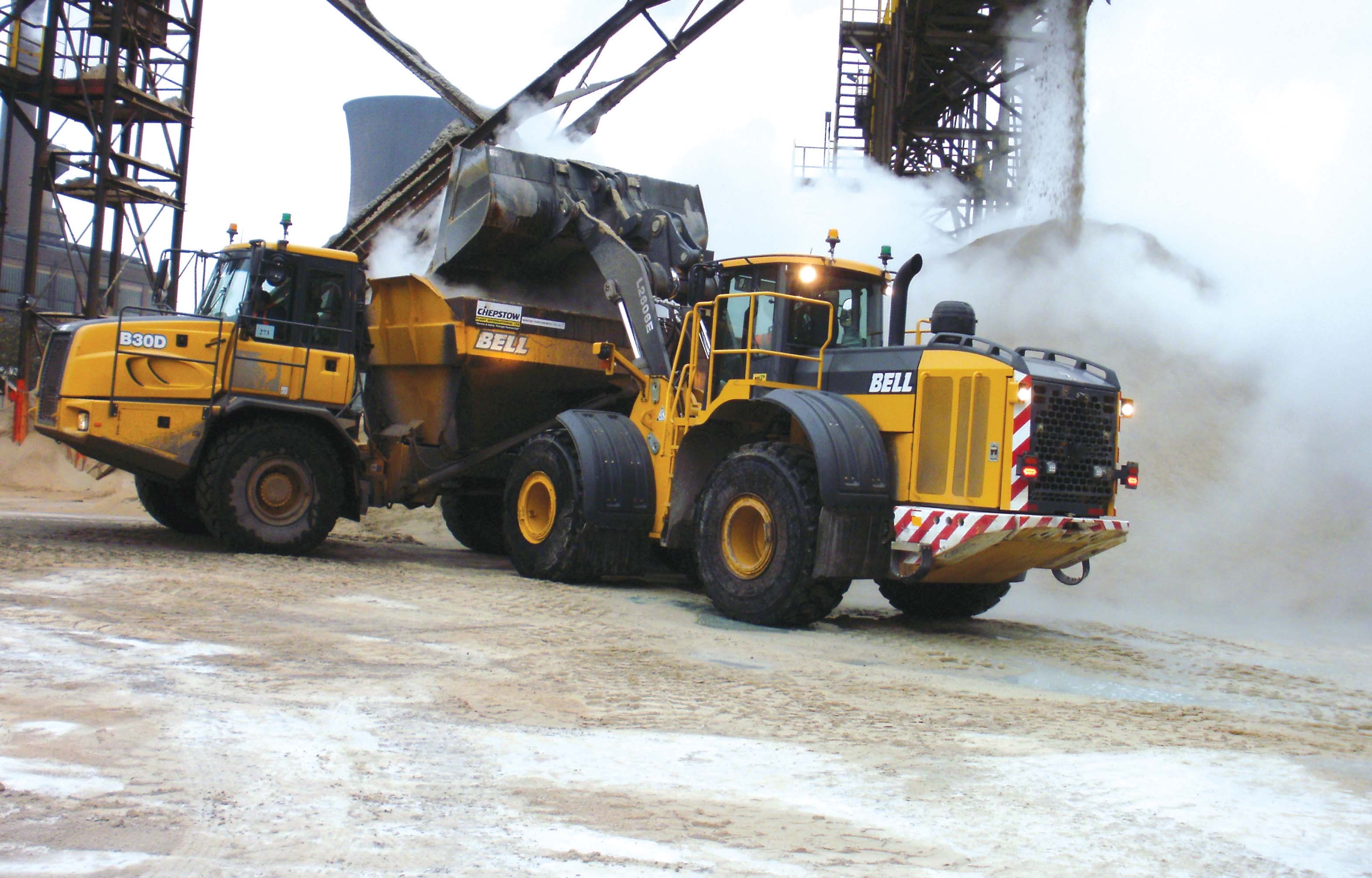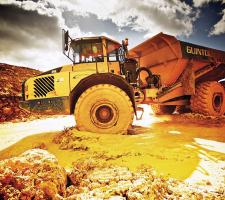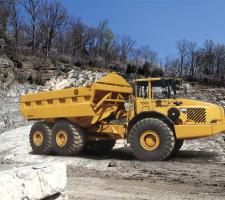
RSSHauling is a major part of the biggest public-private partnership (PPP) contract ever signed in France’s rail sector, as Patrick Smith reports. Indeed, the South Europe Atlantic high-speed rail (SEA HSR) that will run for 302km from Tours to Bordeaux is said to be one of the world’s largest infrastructure projects launched over the last decade.
About 400 Volvo Construction Equipment (CE) machines are being used at the SEA HSR development that will pass through a giant chunk of Western France–Centre, Poitou-Charentes and Aquitaine, and eventually reduce the journey time between Paris and Bordeaux by approximately one hour and as many as 20 million passengers will benefit from the high-speed transport service.
For the Poitou-Charentes section of work, a consortium of companies,
The whole project will cost some €7 billion and involves removing 46 million m³ of soil (more than half of which will then be reused); construction of 415 new bridges as well as 10,000m of viaducts.
The line is scheduled to open for passengers in 2017.
The Volvo Construction Equipment (
“Three-quarters of our machines are haulers, mostly Volvo A30Fs with the latest emissions-compliant Stage IIIB engines, which meant organising training courses for operators before the work began,” says Thierry Lenoble, Sofemat technical coordinator. He works with a team of seven mechanics to ensure the company’s machines keep to a tight deadline.
Volvo CE’s F-Series articulated haulers also feature a package of improvements in functionality, design, and maintenance.
Ranging from the 24tonne A25F up to the 39tonne A40F, the self-compensating hydro-mechanical system is said to afford exceptionally short turning circles, useful in confined loading and dumping areas and on tightly turning haul roads.
“When we started, we had to acquire the land, carry out demolition and tree removal, strip away the topsoil and then start work on earthworks, cuttings and embankments,” says Philippe Gutleben, project director. “We will do everything until it’s time to lay the rail track. I’ve worked on civil engineering projects like this one since 1993, where very challenging terrains are involved. I know all about Volvo’s articulated haulers and wheeled loaders and how they’ve kept evolving.”
Indeed, late last year the
The truck business manufactures and sells off-highway rigid and articulated haul trucks, and included in the transaction is the manufacturing facility in Motherwell, Scotland. The sale is targeted to close in the first half of 2014.
“The truck business has been an important part of our company for more than three decades and continues to produce world-class products with dedicated and talented employees,” says Ron DeFeo, Terex chairman and CEO.
“However, trucks no longer fit within our changing portfolio of lifting and material handling businesses. I am confident that the truck business will benefit by joining a company sharing similar competencies and offering complementary products and services. We are pleased to have entered into this agreement with Volvo, which represents a strong strategic buyer for the business who values our distribution network and team members.”
Volvo says it is a “strategic acquisition that offers Volvo CE considerable scope for growth. The addition of a well-respected range of rigid haulers extends the earthmoving options for customers involved in light mining applications at a time of renewed confidence in the sector. The addition of TEL’s articulated hauler range will enhance our position in this segment, particularly in high-growth markets.”
One such market could well be Myanmar where Leadway Heavy Machinery, a new distributor for
Redesigned for added value are
“The design of the new models centres largely on customer requests for increased productivity, lower operating costs, superior availability, long-term durability, added rimpull/retarding capability, ease of operation, high resale value, and maximum rental margins,” says Caterpillar.
The 725C has a rated payload capacity of 23.6tonnes and the 730C and 730C EJ models are rated at 28tonnes.
The 725C’s Cat C9.3 ACERT engine is rated at 234kW, and the Cat C13 ACERT in the larger models has 274kW.
“All three models are available in US EPA Tier 2/EU Stage II equivalent, Tier 3/Stage IIIA equivalent or Tier 4-Final/Stage IV configurations to meet worldwide emissions standards,” says Caterpillar.
“A diesel particulate filter and Selective catalytic reduction system provide exhaust after-treatment for Tier 4-Final/Stage IV models.”
Compared with predecessor models, the 725C has a 4% gain in gross power and a 20% boost in gross torque; 730C and 730C EJ models have nearly 16% more gross power and more than a 30% gross torque improvement.
Also new are the Cat 770G and 772G off-highway trucks incorporating many features introduced on larger Cat G Series trucks. With nominal rated payload capacities of 36.3tonnes and 47.1tonnes respectively, the new trucks use Cat C15 (770G) and C18 (772G) engines, with net power ratings of 356kW (770G) and 410kW (772G).
The 770G and 772G now come standard with VIMS 3G, the Caterpillar Vital Information Management System; Truck Production Management System (TPMS), TMPH (ton mile per hour)/TKPH (tonne kilometre per hour) tyre management system, and Product Link (standard or cellular). The Advisor display in the cab provides an onboard interface for these information systems.
Meanwhile, 11 articulated dump trucks from
Bell Equipment says the machines showcase the company’s range of size options available, with capacities from 25-40tonnes.
Chepstow has taken delivery of four B25Ds, three B30Ds, two B35Ds and two B40Ds, saying one of the key drivers behind its continued usage of Bell Equipment is Fleetm@tic, the advanced in-built fleet management system incorporated into all Bell machines.
“We have a high dependency on Fleetm@tic in terms of weight-load information, ensuring our operators do not overload the machines, and also in terms of confirming their fuel economy,” says John Corcoran, managing director.
“Over many years, we have amassed a wealth of data, which gives our customers and ourselves the peace of mind that our Bell ADTs are performing.”
Hitachi Construction Machinery (Europe)/(HCME) says its EH5000AC-3 rigid dump truck is the largest
It features the advanced Hitachi AC Drive System, which was developed using advanced propulsion technology which also powers Japan’s bullet trains.
The new EH5000AC-3 features the third generation Hitachi Drive Control System and this incorporates such functionalities as slip control for traction (similar to active traction control) and slide control for grip (similar to an anti-lock brake system).
The EH5000AC-3 has been designed with a
“Since Hitachi began producing its own drive system with the launch of the EH3500ACII, it has resulted in the rapid development and enhancement of this technology,” says HCME.
In a different vein, in western Poland a new
The truck transports raw materials and is one of six Doosan dump trucks in the mine, where at the mine face a
This is transported using the Doosan DA30, which weighs over 23tonnes (fully loaded over 50tonnes). It was dismantled and taken down the mine via a special mine shaft, and then reassembled.
The DA30 was sold by local company Wigropol, operating as a Doosan sub-dealer in mining equipment.
Salt is delivered from the roadheader by the DA30 truck to the crater, then to the crusher, and onto a double-deck vibrating screen. The process continues until the grain size is less than 5mm, and the salt is conveyed to fine vibrating screens after which it is transported by belt conveyor to a deposit.
From here, the salt is transported by road throughout Poland and Central Europe. Last year, 336,000tonnes of salt was extracted.
“The machine works 15 hours a day, sometimes travelling 5km each way. We therefore appreciate the low exhaust emissions of the
Chinese company
The company is continuing to expand its SRT range of off-highway dump trucks while boosting the sales of these machines in China and for export.
First prototypes for the SRT55 rigid hauler were developed in 2007; production versions started in production in 2008 and the development of the SRT line has continued with the company offering machines with payloads of 33, 45 and 95tonnes as well.
In the next two to three years Sany Mining sees up to 50% of truck sales going to export markets and it is also developing at articulated dump truck which is scheduled to be introduced in May 2014.
Volvo CE’s agreement with Philippi-Hagenbuch
Late last year, Volvo Construction Equipment entered into an international supply agreement with
The agreement spans the entire Volvo CE articulated hauler product line.
PHIL’s standard capacity ejector bodies provide a similar volumetric capacity to the Volvo end-dump body, and custom high-volume designs are available for applications that transport lighter density materials such as landfill and refuse operationsRSS

















